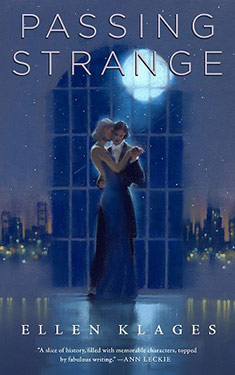Ellen Klages
Completed 3/27/2019,
Reviewed 3/27/2019
5 stars
Last year, I
read 94 books and gave out ten five-star ratings. The last one was in September. This year, it took 24 books and nearly three
months before awarding another five stars.
I was so moved by this novella that I had to walk around the apartment
to work off the emotions that had settled in my gut. I loved this story about queer women in 1940
San Francisco. It tells of lesbian love
in a time rife with homophobia and racism.
And there’s a little magic thrown in the mix. If the magic were more subtle, I would have
called it Magical Realism, but really, it’s fantasy. The book won the Gaylactic Spectrum Award for
positive LGBTQ content in speculative fiction, won the World Fantasy and British
Fantasy Awards for Best Novella, and was nominated for the Nebula Award for
Best Novella and the Mythopoeic Award.
The story begins
with Helen, an old lawyer with a terminal illness who possesses the last
painting by the acclaimed artist Haskell.
She spends her last day selling the painting and divvying up the
proceeds among friends and charities before taking pills to end her life. This is not a spoiler; it’s the first
chapter. The book then goes back to 1940
where a circle of lesbian friends gathers for a dinner party. There we meet Helen as a young woman, Franny,
Babs, Haskell, and newcomer Emily. The
group regularly hangs out at Mona’s, a bar where women dress as men, and is
frequented by the lesbian community as well as straight Midwest couples who
come to gawk and be amazed at the drag kings show. One night after the dinner party the group goes
to Mona’s where Haskell is astounded to find that Emily is the star of the nightly
show as her alter ego Spike. Haskell and
Emily fall in love and the two become a couple.
Of course, life for lesbians is not easy in 1940, even in San Francisco. It’s even more complicated by the fact that
Haskell is still married to a man.
As I
mentioned above, this is a novella, under 220 pages. Yet it finds a way to encompass a romance
while presenting hard facts about homophobia and racism. There’s a scene where Spike’s female piano
player is roughed up and arrested by the police for wearing men’s clothing
without wearing the required three articles of women’s clothing. There’s also a scene in a Chinatown supper
club that caters to whites where the host is chock full of racist jokes at the
expense of the Asian performers. Times were
hard for people of color and for the queer community. The author did a lot of research on old San Francisco
and it’s evident in how she captured these issues in these scenes.
I can’t
really discuss the magic in the story as it comes to play at the climax of the
story and would be a spoiler. And if
there’s any criticism one could have for the book, it would be that the magic
system is not fully elaborated upon, except for the fact that it’s old-country
magic. In that sense, it is a bit like
Magical Realism, that is, magic in a real-world or mundane setting. But I think Magical Realism often uses myth
or allegory, and this book does not.
Still, it’s wonderful how it’s presented.
One of the
best things about the book is how it portrays this group of friends. It captures a common occurrence in the LGBTQ
community, where friends become family when biological families reject them. The whole middle part of the book is about
Haskell and Emily, but we get enough of a sense of who the others are so that
it is only natural that they all come together to help the lovers in their time
of need.
My requirement
for giving a five-star rating is that the book is excellent AND moves me emotionally
in some profound way. I didn’t cry at
the end, but the book made my whole insides quiver. The prose was elegant without being
overbearing. The dialogue was realistic
and natural. At the end, I wished I
could have stayed with these women longer, gotten to know them all much more
deeply. But if it were longer, it may
not have been the perfect little book that I won’t be able to stop gushing
about for days.

No comments:
Post a Comment